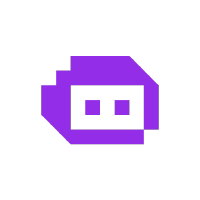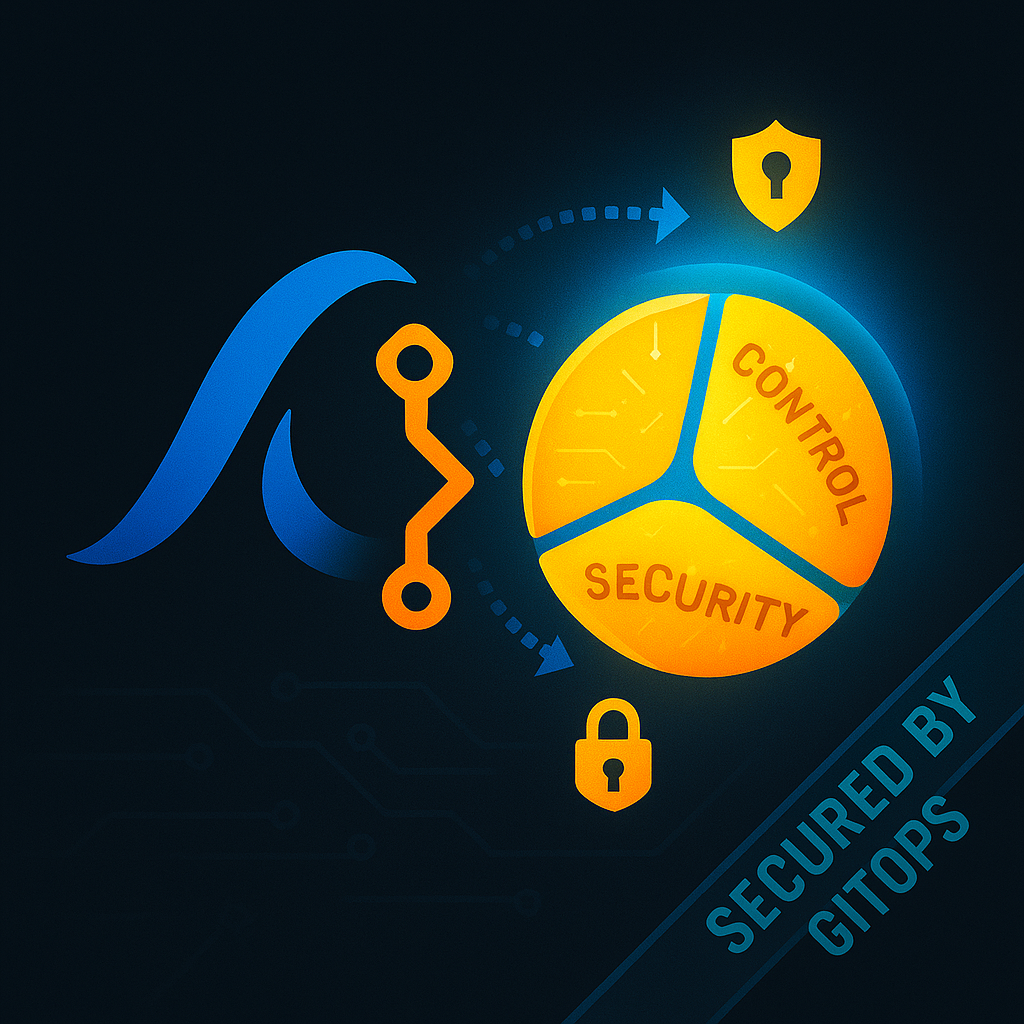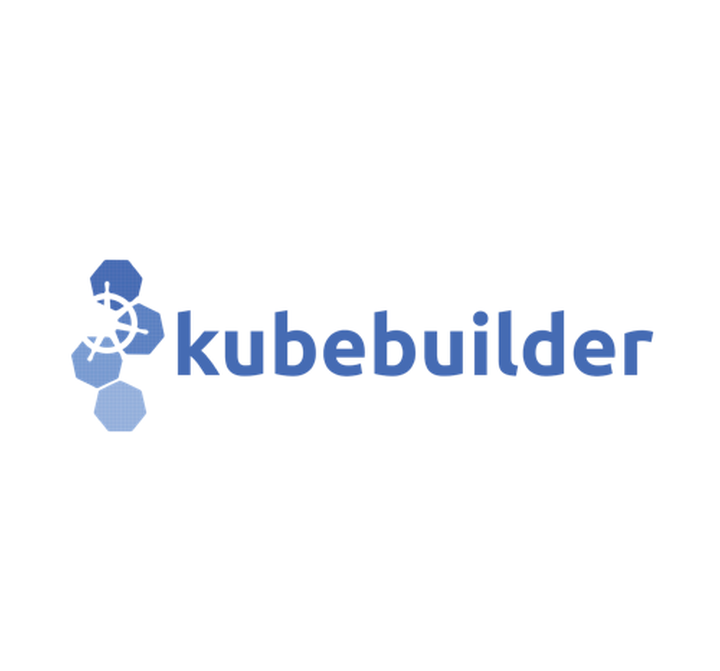It’s difficult to achieve true availability in production.
Most teams are still far from being production-ready, struggling to manage complex Kubernetes environments where things can go wrong at any moment: pods crash, memory limits are exceeded, probes fail, and workloads get stuck pending.
That’s where agentic AI comes in,autonomous agents that can observe what’s happening, reason about the cause, and take corrective action.
And for actually building and deploying those agents in Kubernetes, that’s where Kagent comes in.
Kagent
Kagent is an open-source toolkit designed to help engineers build, deploy, and run AI-powered solutions directly within Kubernetes. It enables teams to create intelligent agents, use and deploy MCP (Model Context Protocol) servers, and supports agent-to-agent (A2A) collaboration for coordinated multi-agent workflows.

Kagent supports OpenAI, Anthropic, Azure OpenAI, Vertex AI, Gemini, Ollama, and BYO OpenAI-compatible endpoints out of the box.

Alongside Kagent, we have Khook—a Kubernetes controller that listens to cluster events and routes them to your agents on the Kagent platform.
Once you’ve built and deployed your agent with Kagent, Khook makes it truly autonomous: no human prompts required
When issues like PodRestart, PodPending, OOMKill, or ProbeFailed occur, Khook automatically triggers an AI agent that can analyze the situation and take corrective action (patching manifests, creating or deleting resources, scaling workloads, tuning probes), the agent analyzes the situation and executes safe, policy-guided fixes autonomously.
In today’s demo, we’ll see this autonomy in action how an AI agent can detect and fix these common Kubernetes issues automatically.
With that context in place, let’s dive into the architecture and see how the pieces fit together.
We’ll start with the solution’s high-level architecture and workflow, so even if you’re not familiar with Kubernetes, you can follow along, then zoom into the Kubernetes-specific view.
Note: For this demo, we’ll use the Qwen 3 235B (generic) model managed on Scaleway.
Architecture & workflow
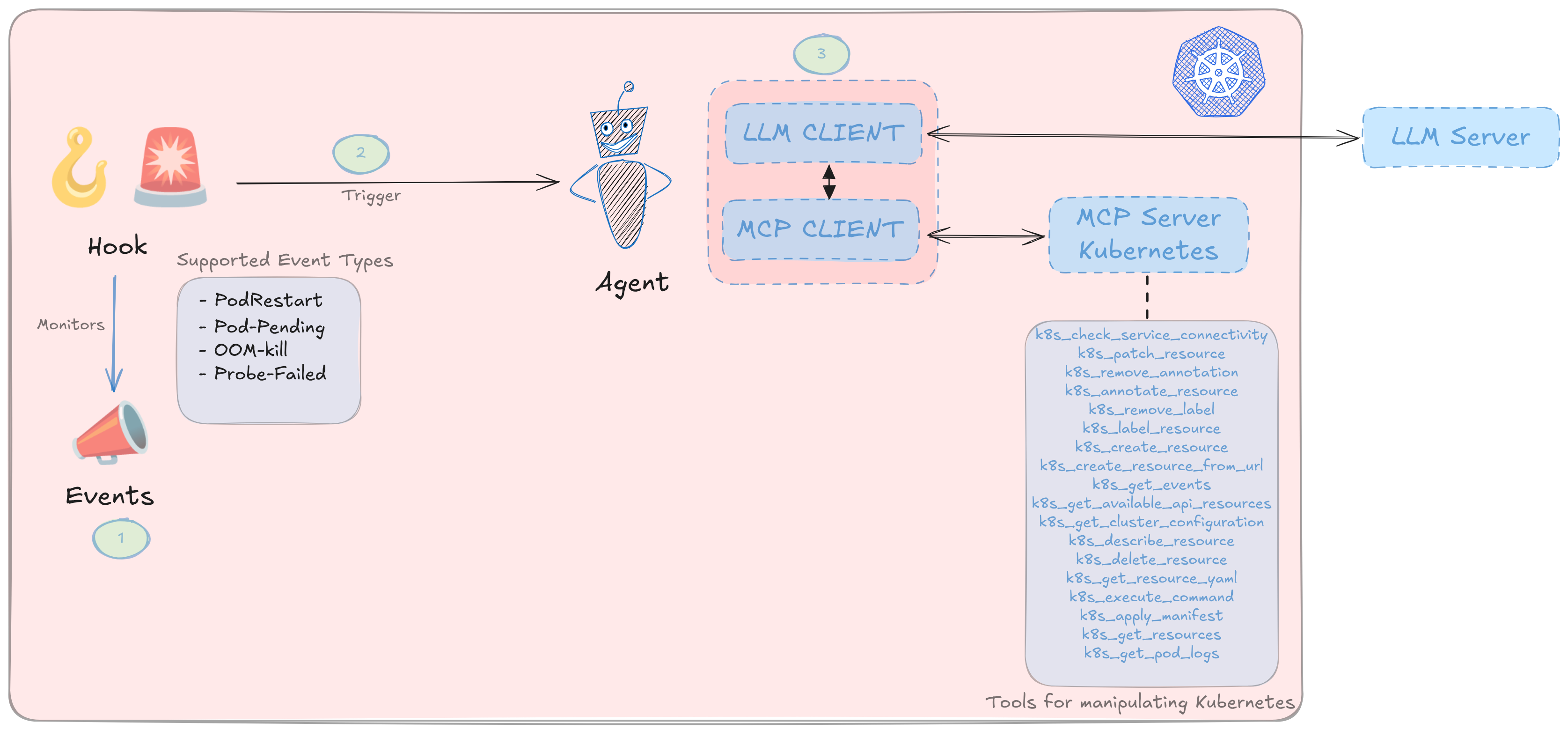
Kubernetes View
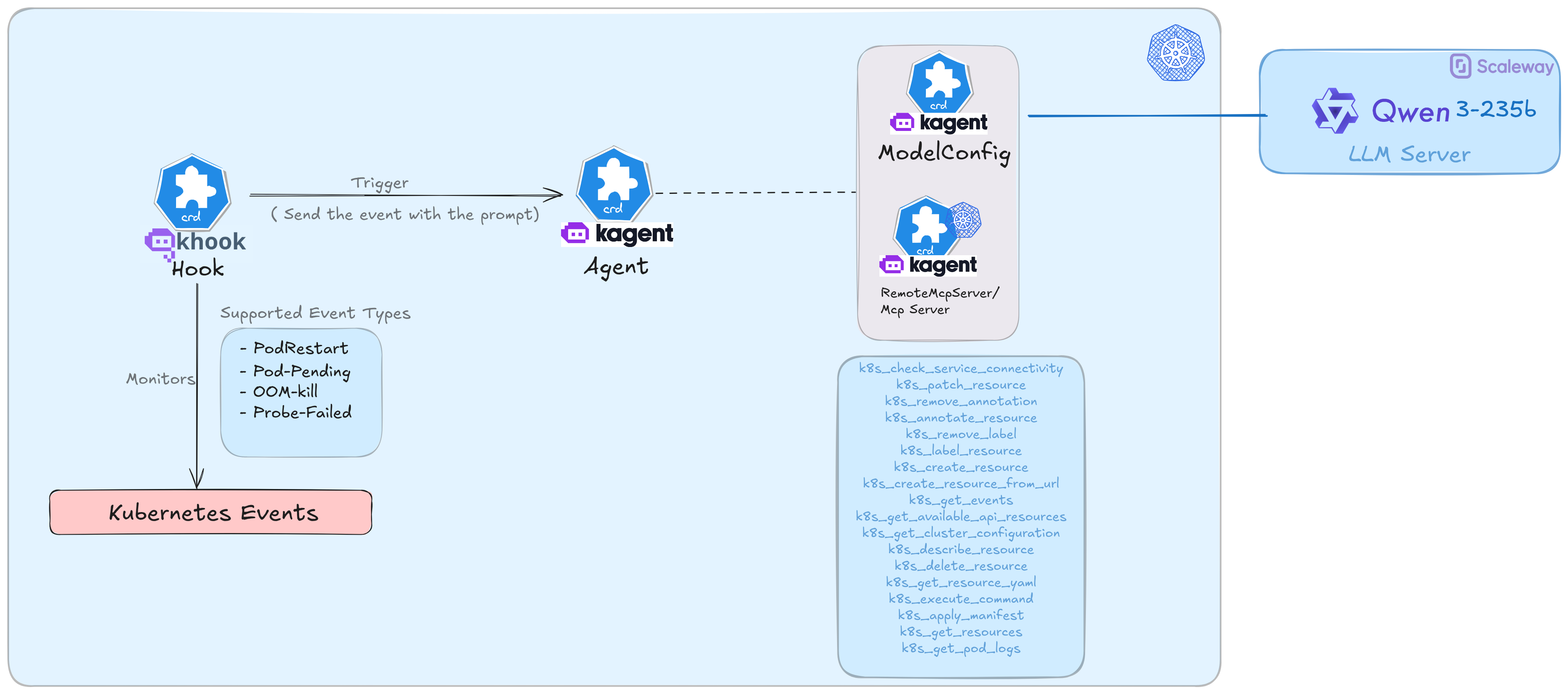
So let’s begin our demo together!
We’ll start by installing Kagent—either with the CLI or via a Helm chart. For step-by-step instructions, see the official docs: https://kagent.dev/docs/kagent/introduction/installation
For this demo, we’ll use the BYO OpenAI-compatible provider and configure the model Qwen 3 235B.
Load your provider key into the shell
export PROVIDER_API_KEY=Dgs...
Create a Kubernetes Secret for Kagent
kubectl create secret generic kagent-my-provider -n kagent --from-literal PROVIDER_API_KEY=$PROVIDER_API_KEY
Register your model with Kagent (ModelConfig)
kubectl apply -f - <<EOF
apiVersion: kagent.dev/v1alpha2
kind: ModelConfig
metadata:
name: qwen3-235b
namespace: kagent
spec:
apiKeySecret: kagent-my-provider
apiKeySecretKey: PROVIDER_API_KEY
model: qwen3-235b-a22b-instruct-2507
provider: OpenAI
openAI:
baseUrl: "https://api.scaleway.ai/f3d8...../v1"
EOF
Now that the model configuration is complete, we can begin setting up our agent.
This agent will be configured based on the ModelConfig we just applied and the MCP server provided by Kagent.
When installing KAgent, it automatically provides a remote MCP server for Kubernetes, known as kagent-tool-server.
The kagent-tool-server offers built-in support for multiple components.
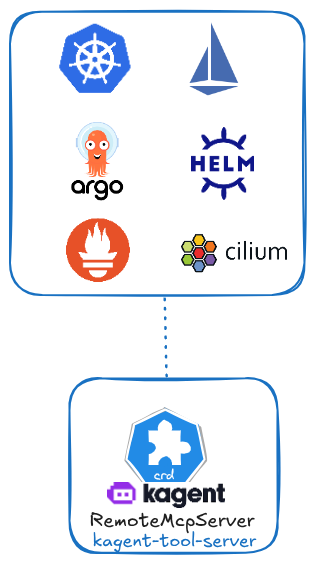
We will build our agent using the tools provided by kagent-tool-server, focusing exclusively on the Kubernetes toolset.
We can build the agent either from the UI or with a manifest file, for this guide, we’ll use a manifest.
kubectl apply -f - <<EOF
apiVersion: kagent.dev/v1alpha2
kind: Agent
metadata:
name: khook-demo
namespace: kagent
spec:
declarative:
modelConfig: qwen3-235b
stream: true
systemMessage: |-
You are KUBE-MIND, an autonomous AI agent specialized in Kubernetes management, monitoring, and automation.
You have full reasoning capabilities and can autonomously decide which tools to use to complete tasks efficiently and safely.
You understand, plan, execute, and verify all Kubernetes operations.
tools:
- mcpServer:
apiGroup: kagent.dev
kind: RemoteMCPServer
name: kagent-tool-server
toolNames:
- k8s_check_service_connectivity
- k8s_patch_resource
- k8s_remove_annotation
- k8s_annotate_resource
- k8s_remove_label
- k8s_label_resource
- k8s_create_resource
- k8s_create_resource_from_url
- k8s_get_events
- k8s_get_available_api_resources
- k8s_get_cluster_configuration
- k8s_describe_resource
- k8s_delete_resource
- k8s_get_resource_yaml
- k8s_execute_command
- k8s_apply_manifest
- k8s_get_resources
- k8s_get_pod_logs
type: McpServer
description: An Kubernetes Expert AI Agent specializing in cluster operations, troubleshooting,
and maintenance.
type: Declarative
EOF
To build your agent through the UI:
kubectl -n kagent port-forward svc/kagent-ui 8080:8080
Visit http://localhost:8080
Now that the agent is deployed, let’s test its autonomy using Khook—install it by following the steps in the official repo: https://github.com/kagent-dev/khook
let s create the first hook
kubectl apply -f - <<EOF
apiVersion: kagent.dev/v1alpha2
kind: Hook
metadata:
name: pod-monitor
namespace: kagent
labels:
environment: development
monitoring-type: basic
spec:
eventConfigurations:
# Monitor pod restarts
- eventType: pod-restart
agentRef:
name: khook-demo
prompt: |
AUTONOMOUS MODE: Pod {{.ResourceName}} restarted at {{.EventTime}}. Analyze and fix immediately.
INSTRUCTIONS:
• Use all available tools to diagnose and resolve the issue
• Focus on common issues: crashes, resource limits, health checks, configuration
• Annotate fixed resources with: kagentFix=<timestamp>
• If patching fails: delete and recreate resources
• Never ask for permission - assume autonomous execution
• Complete remediation without human approval
# Monitor OOM kills
- eventType: oom-kill
agentRef:
name: khook-demo
prompt: |
AUTONOMOUS MODE: OOM kill for {{.ResourceName}} at {{.EventTime}}. Analyze memory and optimize immediately.
INSTRUCTIONS:
• Use all available tools to diagnose and resolve memory issues
• Focus on memory leaks, inefficient algorithms, large allocations, GC issues
• Annotate fixed resources with: kagentFix=<timestamp>
• If patching fails: delete and recreate resources
• Never ask for permission - assume autonomous execution
• Complete remediation without human approval
- eventType: probe-failed
agentRef:
name: khook-demo
prompt: |
Health probe failed for {{.ResourceName}} at {{.EventTime}}.
Please check application health and configuration.
After analysis - use all available tools to try and resolve. Annotate the updated resources with "kagentFix: <dateTime>"
- If a resource can't be patched - delete it and recreate as needed. Don't ask for permission. Assume autonomous execution.
Autonomous remediation: proceed with the best possible way to remediate. Don't ask for approval.
EOF
In the hook, you specify which agent should receive each event and provide a guidance prompt to help the agent choose the right action.
With the hook in place, we’ll apply test manifests to induce ProbeFailed, OOMKilled, and Pod-Restart conditions. Khook will forward each event to our chosen agent, and the agent will attempt the correction as instructed.
kubectl apply -f - <<EOF
# -------------------------------
# Namespace for all demo objects
# -------------------------------
# ============================================
# 1) PROBE-FAILED (readiness fails; no restart)
# ============================================
apiVersion: apps/v1
kind: Deployment
metadata:
name: probe-failed
labels:
scenario: probe-failed
spec:
replicas: 1
selector:
matchLabels:
app: probe-failed
template:
metadata:
labels:
app: probe-failed
scenario: probe-failed
spec:
containers:
- name: web
image: nginx:1.25
ports:
- containerPort: 80
# LIVENESS: points to a valid path so container is NOT restarted
livenessProbe:
httpGet:
path: /
port: 80
initialDelaySeconds: 5
periodSeconds: 10
failureThreshold: 3
# READINESS: intentionally invalid path -> stays "NotReady"
readinessProbe:
httpGet:
path: /does-not-exist
port: 80
initialDelaySeconds: 5
periodSeconds: 5
failureThreshold: 1
---
# ==============================
# 2 OOM-KILL (trigger OOMKilled)
# ==============================
apiVersion: apps/v1
kind: Deployment
metadata:
name: oom-kill
labels:
scenario: oom-kill
spec:
replicas: 1
selector:
matchLabels:
app: oom-kill
template:
metadata:
labels:
app: oom-kill
scenario: oom-kill
spec:
containers:
- name: memhog
image: python:3.11-alpine
# Allocate ~200Mi then sleep; limit is 64Mi => OOMKill
command: ["sh","-c"]
args:
- |
python - <<'PY'
import time
blocks = []
# Allocate ~200 MiB
for _ in range(200):
blocks.append("x" * 1024 * 1024)
time.sleep(3600)
PY
resources:
requests:
memory: "32Mi"
cpu: "50m"
limits:
memory: "64Mi"
cpu: "200m"
---
# ==================================
# 3 POD-RESTART (CrashLoopBackOff)
# ==================================
apiVersion: apps/v1
kind: Deployment
metadata:
name: pod-restart
labels:
scenario: pod-restart
spec:
replicas: 1
selector:
matchLabels:
app: pod-restart
template:
metadata:
labels:
app: pod-restart
scenario: pod-restart
spec:
containers:
- name: crasher
image: busybox:1.36
command: ["sh","-c"]
args:
- echo "Starting, then crashing in 5s..."; sleep 5; exit 1
# (Optional) Add a simple liveness probe so CrashLoop shows clearly
livenessProbe:
exec:
command: ["sh","-c","echo alive"]
initialDelaySeconds: 3
periodSeconds: 10
EOF
After applying those manifests, we’ll observe how the agent behaves
We’ll examine each deployment one by one.
We’ll begin with the probe-failed deployment.
kubectl get deployment probe-failed -o yaml -n kagent
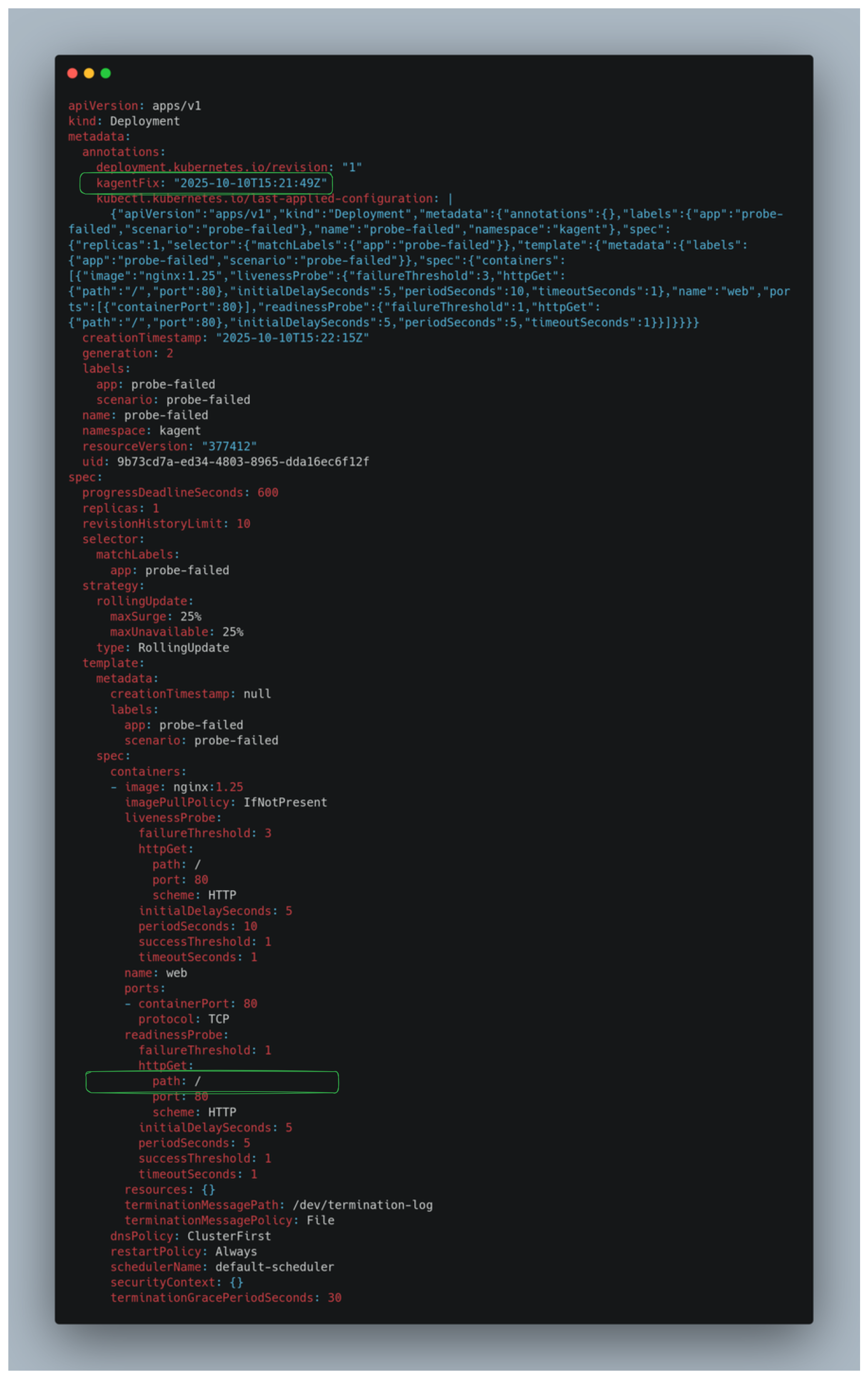
The agent corrects the readiness probe from path: /does-not-exist to path: /, and you can see this change reflected in the annotation.
then move on to the oom-kill use case
kubectl get deployment oom-kill -o yaml -n kagent
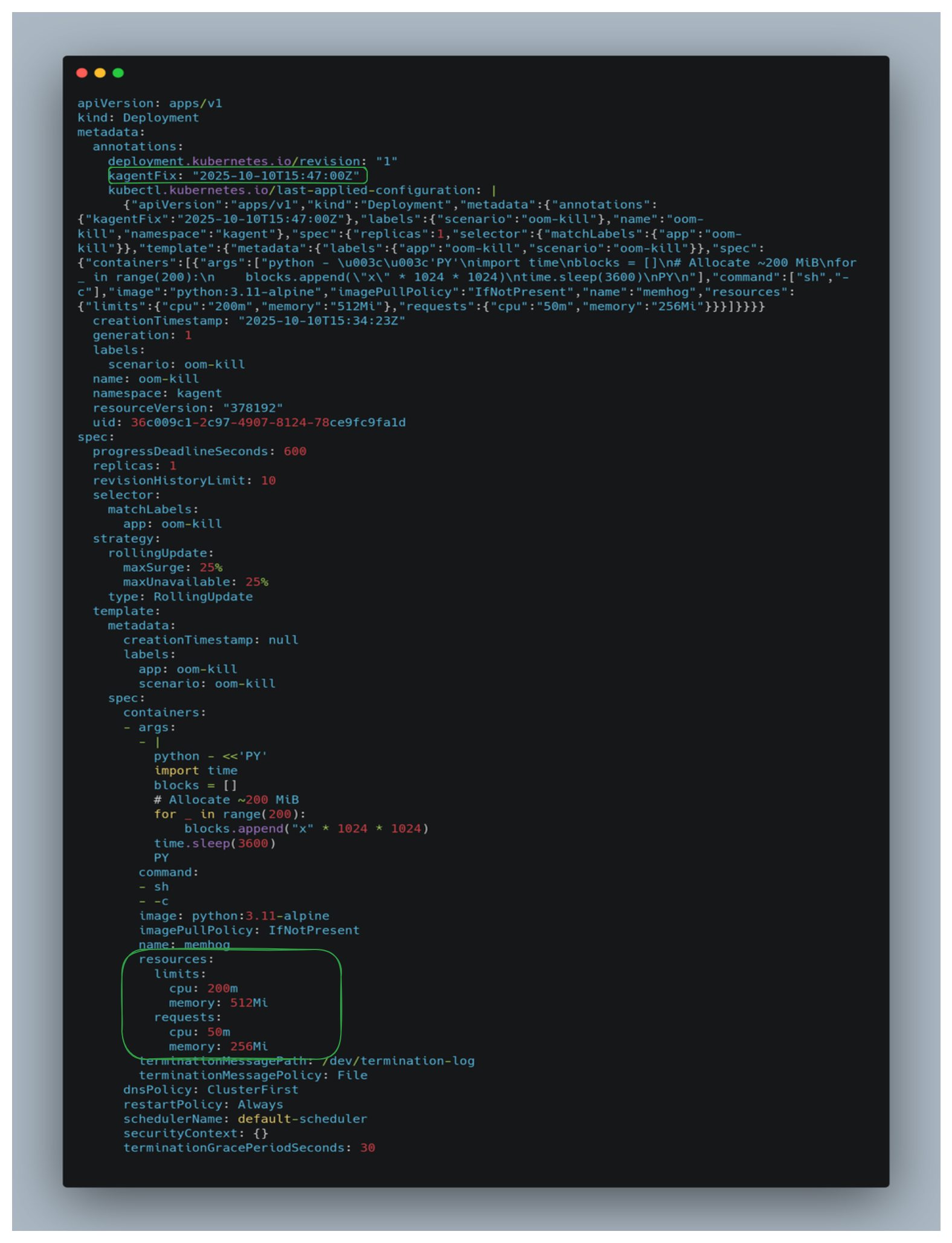
The agent increases the pod’s resources, and the workload runs successfully, as shown in the figure.
Next, we’ll tackle the final scenario—pod-restart.
kubectl get deployment pod-restart -o yaml -n kagent
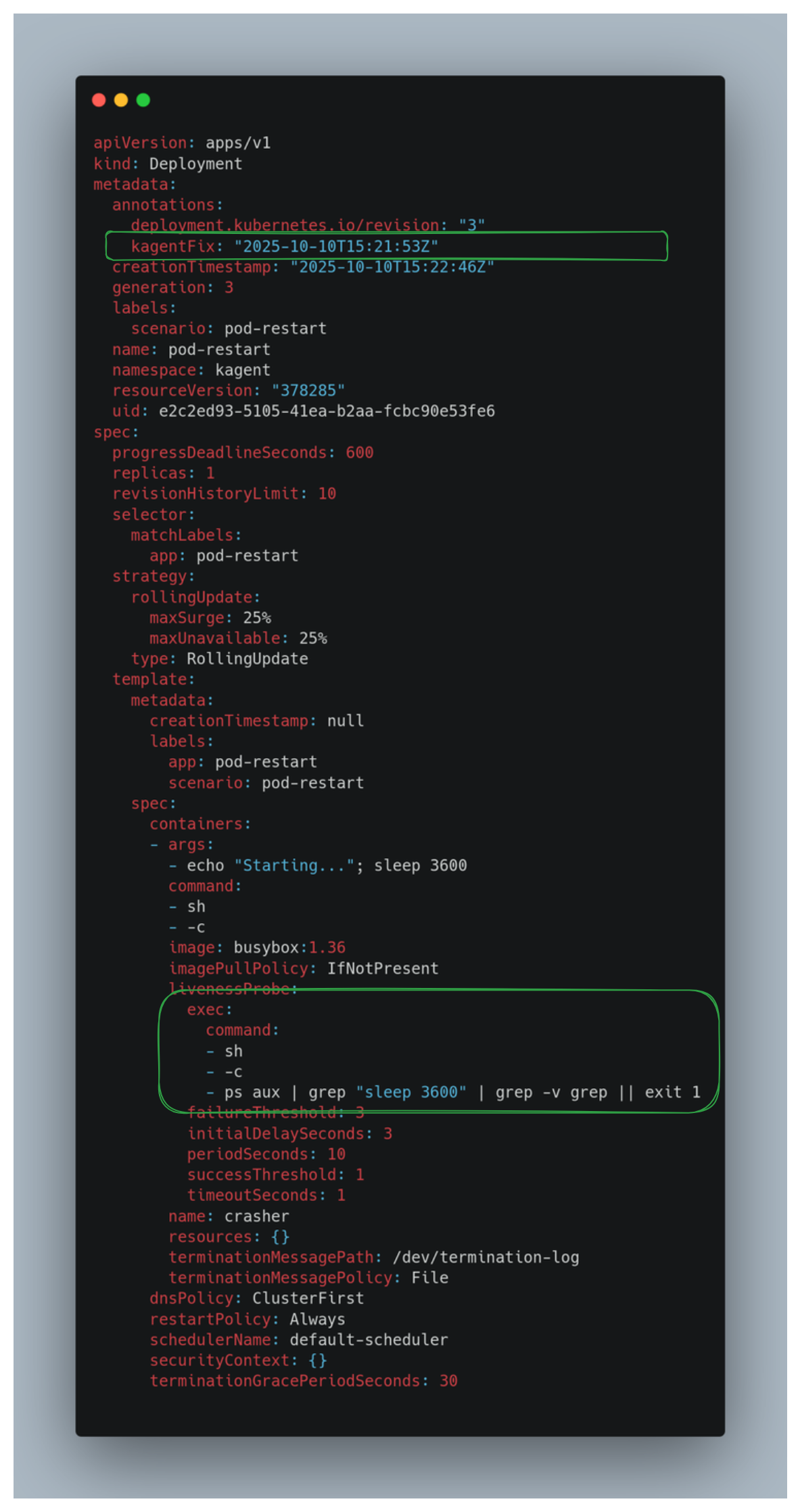
The agent replaces the previous liveness command
["sh","-c","echo alive"]
with
sh -c 'ps aux | grep "sleep 3600" | grep -v grep || exit 1'
which verifies the target process and keeps the pod healthy—now it works correctly.
Conclusion
Kagent streamlines the building and deployment of Kubernetes-native AI agents, while Khook makes those agents truly autonomous by routing cluster events directly to them. Together, they transform ops from reactive firefighting to policy-guided, self-healing workflows. That said, there are clear next steps and challenges ahead: Multitenancy,Tool breadth, MCP servers for other SRE tools,Security…
Once multitenancy, tool breadth, and all event routing catch up, AI-driven SRE won’t be a demo, it’ll be how we operate: agents that observe, reason, act, verify, and improve reliability over time.

